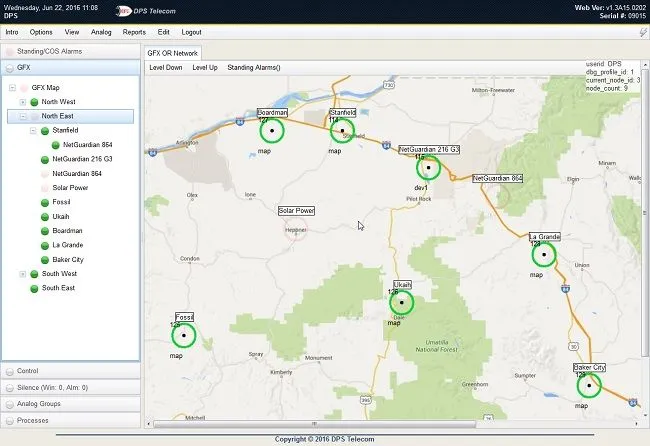Check out our White Paper Series!
A complete library of helpful advice and survival guides for every aspect of system monitoring and control.
1-800-693-0351
Have a specific question? Ask our team of expert engineers and get a specific answer!
Sign up for the next DPS Factory Training!

Whether you're new to our equipment or you've used it for years, DPS factory training is the best way to get more from your monitoring.
Reserve Your Seat TodayNetwork monitoring software is crucial for maintaining an efficient, secure, and high-performing business network.
Note about my experience: DPS Telecom equipment is telco-grade and built to survive in harsh remote locations. I have installed RTUs and network monitoring software in both IT and industrial telecom environments. Both of these scenarios demand high-quality equipment. Industrial telecom has the additional demand of requiring more rugged equipment.

Since this is a broad topic, we'll start with a general definition. Next, we'll discuss different possibilities for network monitoring:
Network monitoring software oversees traffic, performance, and availability. It identifies potential issues early, preventing severe problems and network downtime.
Network monitoring tools act as the IT professionals' eyes and ears. They monitor the network infrastructure continuously. This includes data collection regarding network traffic, usage patterns, and equipment performance.
In industrial telecom settings, network monitoring isn't just about keeping an eye on digital data to prevent security threats. It also involves watching out for physical threats. Possible physical dangers include extreme temperatures and unauthorized access, which can harm your equipment and shorten its life.
For instance, too much heat can quickly damage telecom gear, causing it to fail more often. This can be expensive to fix or replace. Also, leaving doors open to important equipment areas can damage or manipulate gear as a result of environmental risks.
Modern network monitoring systems in these settings have sensors and tools that constantly check the surroundings to address problems. These systems can quickly tell operators if the temperature gets too high or if important doors are open. This ensures that you can take quick action to avoid equipment damage and network outages.
You can get a complete view of the network's health by adding environmental monitoring to network monitoring software. This will also provide information on the physical condition of the telecom infrastructure.
This monitoring keeps the network reliable and extends its life. Combining digital and physical monitoring marks a substantial step forward in managing industrial telecom networks. Overlooking either aspect can lead to significant costs.
Timely detection of irregularities or threats allows for quick responses. The software also provides detailed reports and analytics. These help in both immediate problem resolution and long-term planning. Maintaining network integrity and reliability is crucial, especially in IT and industrial telecom networks.
Selecting the right network monitoring software starts with evaluating your business needs. Consider the scale and complexity of your network and your specific requirements. A small business will differ from a multinational corporation.
IT networks often monitor bandwidth, server performance, and software updates. Industrial telecom networks focus on physical threats like overheating and hardware failure, especially in remote areas.
You should think about:
Choosing the right software involves evaluating key features that meet your business goals. Consider these essential features:
These features effectively ensure network monitoring. They improve reliability and efficiency in network operations. By focusing on these elements, businesses can choose a software solution that supports both current needs and future growth.
The use of APIs adapt network monitoring tools which allows businesses to customize their systems based on specific needs, making network management more efficient. DPS Telecom's solutions, such as the NetGuardian series and T/Mon, support multiple protocols like SNMP and ASCII, enabling smooth integration of various devices into a single platform. This allows for automated tasks, remote control of equipment, and tailored alert notifications.
APIs also facilitate the scaling of your monitoring system as your network grows, allowing you to integrate new devices and expand alarm capacities without major infrastructure changes. By leveraging these APIs, you can automate routine tasks - such as sending alerts and resetting equipment - while integrating data from legacy and new devices.
Understanding the pricing of network monitoring software is key to making an informed choice. Different pricing models exist, including subscription-based or one-time purchases.
Selecting the right vendor is as important as choosing the software itself. The vendor's reliability can affect your network's stability.
T/Mon LNX stands out as an effective solution for monitoring industrial telecom network activity. The network device is capable of handling the specific challenges of remote and dispersed network sites.
Before purchasing network monitoring software, consider the following steps:
Choosing the right network monitoring software is a strategic decision that impacts your network's efficiency and security. By carefully considering features, costs, vendor options, and specific use cases like those of T/Mon LNX, you can make a well-informed choice. This investment not only supports your current operations but also prepares your network for future challenges and expansions.
Tell us what you're trying to accomplish and our experts will help point you in the right direction.
Call 1-800-693-0351 or email sales@dpstele.com for assistance. You can also set up a 20-minute web demo to see T/Mon for yourself.

Andrew Erickson
Andrew Erickson is an Application Engineer at DPS Telecom, a manufacturer of semi-custom remote alarm monitoring systems based in Fresno, California. Andrew brings more than 18 years of experience building site monitoring solutions, developing intuitive user interfaces and documentation, and opt...